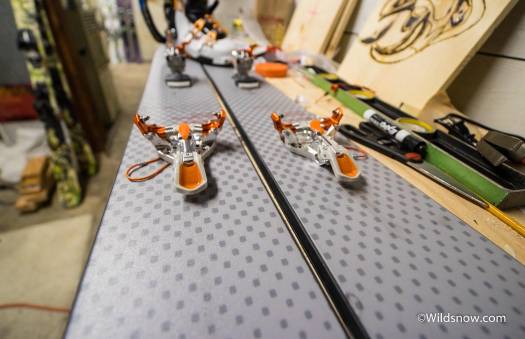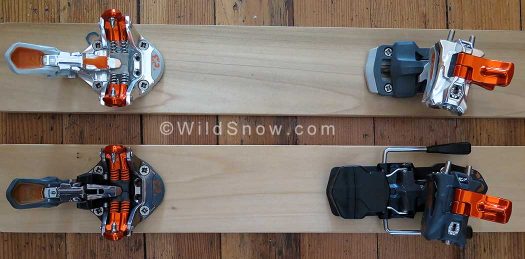G3 has done an excellent job with the ION binding. The design is fairly standard, as far as tech bindings go. However, it’s well thought out, and has some key improvements. It is also well made; all parts are what appears to be reinforced plastic or metal.
I’ve been using the LT since last winter, on a variety of skis. I mounted them on the mega fat DPS Spoon skis. I intended to only use the setup in powder, but ended up skiing them on the occasional icy resort day — not my favorite thing but a good test. Icy conditions, wide skis, and tech bindings set to “normal” release values can be a bad combination. I was cautious initially, but eventually grew confident in the binding’s ability to hold me in. I haven’t pre-released yet in the IONs. Apparently the geometry of the toe unit as well as adequate toe wing pressure make a difference.
Added value re the toe unit performance: Many people find they can tour some distance without locking the toes. That’s nice when you forget to lock, and can be beneficial when tiptoeing through avalanche terrain.
(See our research on tech binding toe wings.)
With their earlier tech binding attempt, the Onyx, G3 made a truly different binding. Unfortunately that meant it wasn’t what many people wanted. With the ION G3 takes a different tact, improving on known issues with the “standard” tech binding design. For example, ION doesn’t seem to be breaking for users near as often as has happened to many (if not most) tech bindings over the years. Further, it has reasonable ramp angle (the higher toe looks odd until you realize it’s just bringing things up closer to the height of your heel), a nice heel-lifter flipper setup, and the heel unit forward-back slider spring locks when you’re in touring mode to prevent wear.
The ION Lt is very similar to G3’s standard ION binding. It cuts weight from the ION through eliminating the brake and the front step-in boot toe locator mechanism. The base plate of the binding is also changed slightly. The functional parts of the binding are all the same as the standard ION. The Lt weighs 482 grams (with screws, no leash) as compared to the standard Ion, which weighs 626 grams (ION 10 with brake and screws).
The ION heal lifters are wonderfully easy to use. They are symmetrical, so it doesn’t matter which way the heel is turned when you flip into touring mode. Also, the lifters have a nice sturdy spring, so they “snap” into place with a little flick (known issue in the first gen, some of the heel lifter “snap” would disappear, this was taken care of on warranty and all of this year’s bindings). Not everything is perfect, one disadvantage to this heel lifter system is gone are the days when I could reach down with my ski pole and rotate the binding heel. Now I have to at least bend over to rotate the heel, or take my skis off. (Since LT doesn’t have brakes, it’s much easier to rotate, ION models with brakes require you do things exactly right or the brake won’t lock up for touring.)
I’m not a big fan of the “step in” boot locator mechanism on the standard G3 ION. It didn’t seem to add much function — it only adds complexity and weight (and cost?). Thankfully, G3 removed that feature on the LT. In fact, in my opinion, G3 removed all the right things to make the ION LT, and nothing they shouldn’t have. In doing so, the created one of the best tech binding options out there. ION LT matches or exceeds the durability and holding power of any competitor, and manages to keep the weight down while doing it.
Louie Dawson earned his Bachelor Degree in Industrial Design from Western Washington University in 2014. When he’s not skiing Mount Baker or somewhere equally as snowy, he’s thinking about new products to make ski mountaineering more fun and safe.


